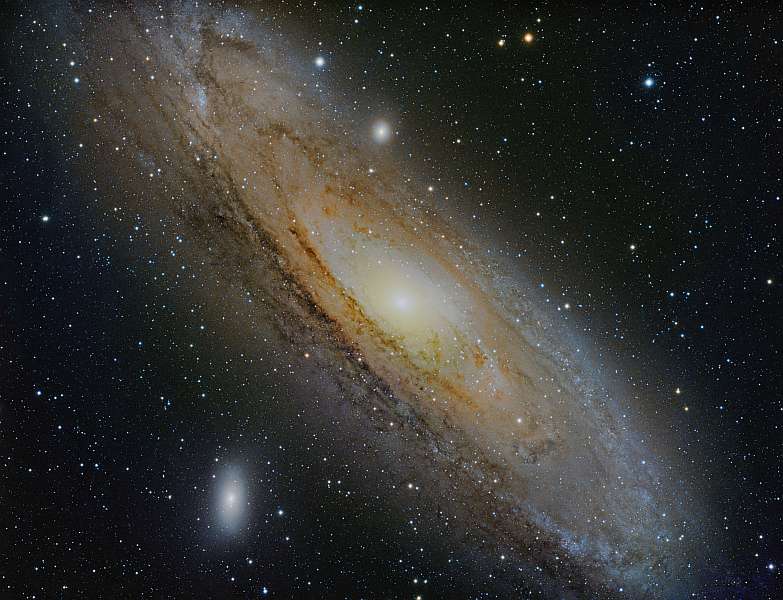M31: The Great Galaxy in Andromeda |
 |
| M31, or the Andromeda Galaxy, is one of the
showpiece objects of the night sky. Inspiring images of this
majestic galaxy have graced many books on astronomy, including
my own foundational book on the subject, "The Universe" from the
Time-Life Nature series. In the course of my readings on astronomy, I noticed some contradictions: at times in some books this object was referred to as "The Andromeda Galaxy", at other times "The Andromeda Nebula". Further readings of books and viewings of TV documentaries on the universe helped clarify the term. Telescopic views of non-stellar deep-space objects tend to have a similar "fuzzy gray object" appearance to them. Thus for the longest time all such objects were described as "Nebulae". "Nebula" (pl: "nebulae") is simply Latin for "cloud". The entire Milky Way looks like a glowing cloud to the naked eye, and was resolved into stars by Galileo when he first turned his telescope to that region. Astronomers that followed him pretty much assumed that any similar "nebula" was simply another cloud of stars much farther away. Up through the early 20th century, our view of the universe was that it was the Milky Way. Period. It was only during the 1920's, when astronomer Edwin Hubble discovered specific types of stars in M31 that helped peg its distance from us, that our view of the universe expanded by a factor of several billion. M31's distance from us suggested that the Milky Way is only one of at least 100 billion galaxies in the entire universe. So now we know - M31 is a galaxy, but can still be described as "nebulous". M31 is visible to the naked eye, though it is best seen at a dark site. This makes it the farthest object (almost 3 million light-years!) visible with unaided vision. I need a pair of binoculars to see its bright core from my back yard. With a large telescope at a dark sky, views of it are breathtaking. This is my most recent attempt, shot from our backyard in Ohio. Here is my 2012 attempt, shot from the dark skies of Rancho Hidalgo, New Mexico. Equipment used was a Takahashi FSQ-106 on an Astro-Physics 1200GTO mount. SBIG STL-6303 camera with built-in filter wheel and Astrodon LRGB filters. This represents 11.3 hours total exposure time (66 x 3 minutes Luminance, 30 x 5 minutes Red, 29 x 5 minutes Green, 37 x 5 minutes Blue). I last shot this in 2006 from our backyard in Ohio, which can be seen here. Prior to that, I shot it back in 2004 (also from our backyard in Ohio), which can be seen here. |
| Object: M31 |
| Constellation: Andromeda |
| When Visible: September - December |
| Distance: 2.5 Million Light-years |
| Date: November 2022 |
| Location: Rancho Hidalgo, New Mexico |
| Exposure Details: L: 123 Minutes (123 x 1 Minute), binned 1x1. R: 60 x 1 minute G: 60 x 1 minute B: 60 x 1 minutes, all binned 1 x 1. 3 hours and 3 minutes total exposure time. |
| Equipment Used: Takahashi FSQ-106 on an Astro-Physics 1200GTO mount. ZWO ASI160MM camera with 7-position/36mm filter wheel and ZWO filters |
| Acquisition Software : MaximDL, CCDAutopilot, FocusMax |
| Processing Software: MaximDL, Adobe Photoshop CS5, IrFanView |
